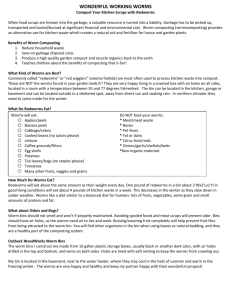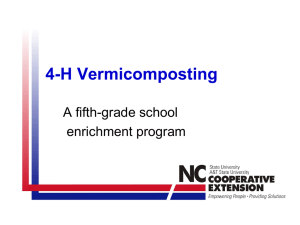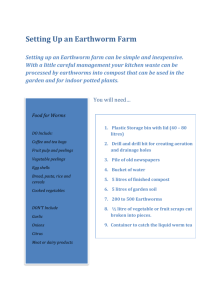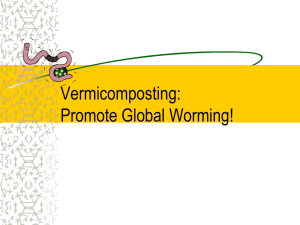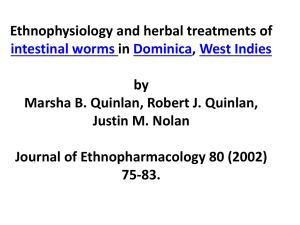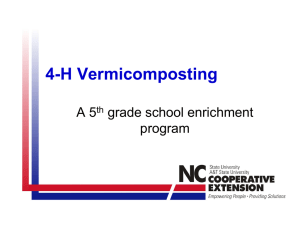The Composting Toolkit - IN Rural Community Assistance Program
advertisement
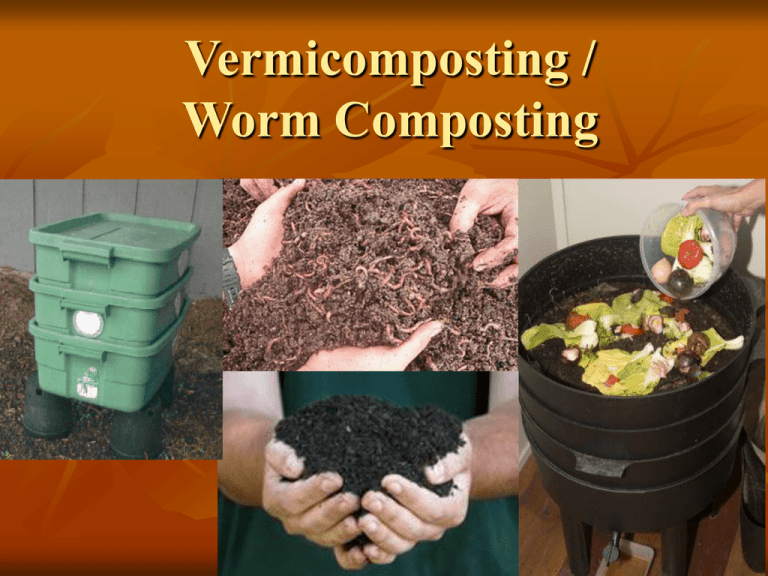
Vermicomposting / Worm Composting Presentation 10: The Composting Toolkit Funded by the Indiana Department of Environmental Management Recycling Grants Program Developed by the Indiana Rural Community Assistance Program RCAP Vermicomposting Vermicomposting is more commonly called “worm composting” Fruit and vegetable matter waste are eaten by redworms The worms produce “castings” that can be utilized as a high quality compost 1 pound of redworms can eat 4 pounds of food waste in a week Vermicomposting Redworms Redworms: Eisenia Foetida. The worms most commonly used for worm composting. Common names: Red wigglers, brandling worms, manure worms. In nature redworms live and feed in the leaf litter along the surface of the soil Types of Food: The YES List Vegetable matter and peels Vegetables too rotten to eat Fruit, rinds, and peels Grains and grain products Breads Beans Coffee grounds and filters Tea leaves and tea bags Unbleached paper products Egg shells (well ground) Types of Food: The NO List Leftovers heavy in oils, milk products, or any meats Meat products and bones Dairy products Eggs Oily foods Salty foods Vinegar Types of Food: The CAUTION List Banana Peels (They can be a source of fruit flies) Pineapple Rinds and Skins (Very acidic) All citrus fruits in large quantities (Acidic) Small amounts of eggs or cheese (Leftovers with very small amounts of either of these is okay) Worm Bins Worm Bins There are many types of worm bins available for purchase It is also fairly easy to construct your own worm bin out of readily available materials. Bins made of opaque materials are better than bins made of clear materials (the worms prefer darkness) Worm Bin Dimensions Shallow is better. Remember that redworms are surface feeders. A container depth of eight to twelve inches is ideal 1 – 2 people: 2 – 3 people: 1 ft. X 1½ ft. X 2 ft. bin / 1 lb. worms 1 ft. X 2 ft. X 2 ft. bin / 1 lb. worms 4 – 6 people: 1 ft. X 2 ft. X 3½ ft. bin / 2 – 3 lbs. worms Look in the Manual for Detailed Construction Instructions Look in the Manual for Detailed Construction Instructions This bin is sized to suit a family of four-six people generating about seven pounds of food waste each week. Materials: 1½” sheet of plywood 1 12' 2x4 1 16' 2x4 2 lbs. 6d galvanized nails 1½ lb. 16d galvanized nails 2 galvanized door hinges Note: Do not use wood that has been pressure-treated or treated with toxic preservatives. Non-toxic wood preservatives are available. Tools: Tape measure, skill saw or rip hand saw, hammer, saw horses, long straight edge or chalk snap line, screwdriver, and drill with ½” bit. Use eye and ear protection. Examples: Homemade Bins Examples: Pre-built Bins Worm Bedding Worm Bedding There are a variety of suitable bedding materials for worm compost bins: Shredded newspaper Shredded cardboard Shredded office paper Leaves Peat moss Operating A Worm Bin By following these simple steps the worms will take care of the composting process for you. Make sure the bin is covered Make sure moisture content stays in an acceptable range: not soaking wet, not too dry Bury all new food waste under existing bedding Plenty of airflow Do not overfeed worms Ideal Conditions For Worm Bins Temperature needs to be kept within a reasonable range: 40 F to 90 F. Freezing temperatures will kill worms as will temperatures over 90 F. pH needs to be kept in balance. The tendency is for a bin to become acidic. Add egg shells, crushed dolomite, or crushed limestone. Worms prefer the dark. Worm Bins: Indoors Or Outdoors? As long as the idea conditions are met a bin can be either indoors or outdoors. In Indiana we do not have ideal year round conditions for a small scale outdoor worm composting bin. Common Problems: Odors Common causes for odor: lack of oxygen, too much water, or generally stinky foods A lack of oxygen can be cured by adding more air holes to the bin and regularly turning the bedding when it becomes stinky. For too much water, add more bedding and/or hold off adding more food waste till bin is drier. Wood bins tend to be less wet than plastic bins. There are some foods, like onions and broccoli, that are smelly while decomposing. If these odors are offensive you might want to eliminate these offending items from the bin. Common Problems: Crawl Outs Worms may crawl out if conditions in the bin are wrong to them. Types of problems: bin too acidic, bin too wet or too dry, atmospheric conditions. Be aware that crawl outs may be sign of a problem needing resolution. Common Problems: Fruit Flies Though fruit flies do not pose a health hazard, these little creatures are a nuisance. Common Problems: Fruit Flies Some techniques to fight fruit flies: Bury food waste in bedding Do not overload the bin Cover food waste with wet newspaper Wash and scrub the skins of fruits and vegetables before placing them in the bin Avoid banana peels Don’t let citrus fruit dominate the bin End Product The worm composting process leaves you with three usable and sellable products: Worms Vermicompost Vermicompost Tea Finished compost can be mixed with potting soil and used for houseplants and patio containers. It is an excellent mulch and premium soil amendment. Some Markets For Worms Other start-up vermicomposting operations Bait and tackle shops Businesses that need worms as food for animals: Fish hatcheries Pet stores Zoos Bird or poultry growers Frog farmers Some Markets For Vermicompost Home improvement centers, nurseries, landscape contractors, greenhouses, garden supply chains, grocery chains, flower shops, general public. Some Markets For Vermicompost Tea Your own house plants Orchards Nurseries Greenhouses Landscapers Retailers Harvesting Finished Compost Keep in mind that the redworms hate light. Use this to your advantage. Place open bin under bright light Remove top layer Leave in light again Repeat Worm Composting: Any Size Worm composting can be successfully conducted as a small, medium, or large scale operation. Larger scale programs have been successfully implemented at institutions such as cafeterias, hospitals, schools and universities, prisons, and military bases. Large Scale Worm Composting Large Scale Worm Composting Large Scale Worm Composting QUESTIONS? Thank You! Additional Questions, Comments, or You Think You Have A Potential Pilot Community Please Feel Free to Contact Me: Mark W. Davis Technical Assistance Provider Rural Community Assistance Program Office: 1-800-382-9895 Wireless: (812) 320-0720 E-mail: mdavis@incap.org
